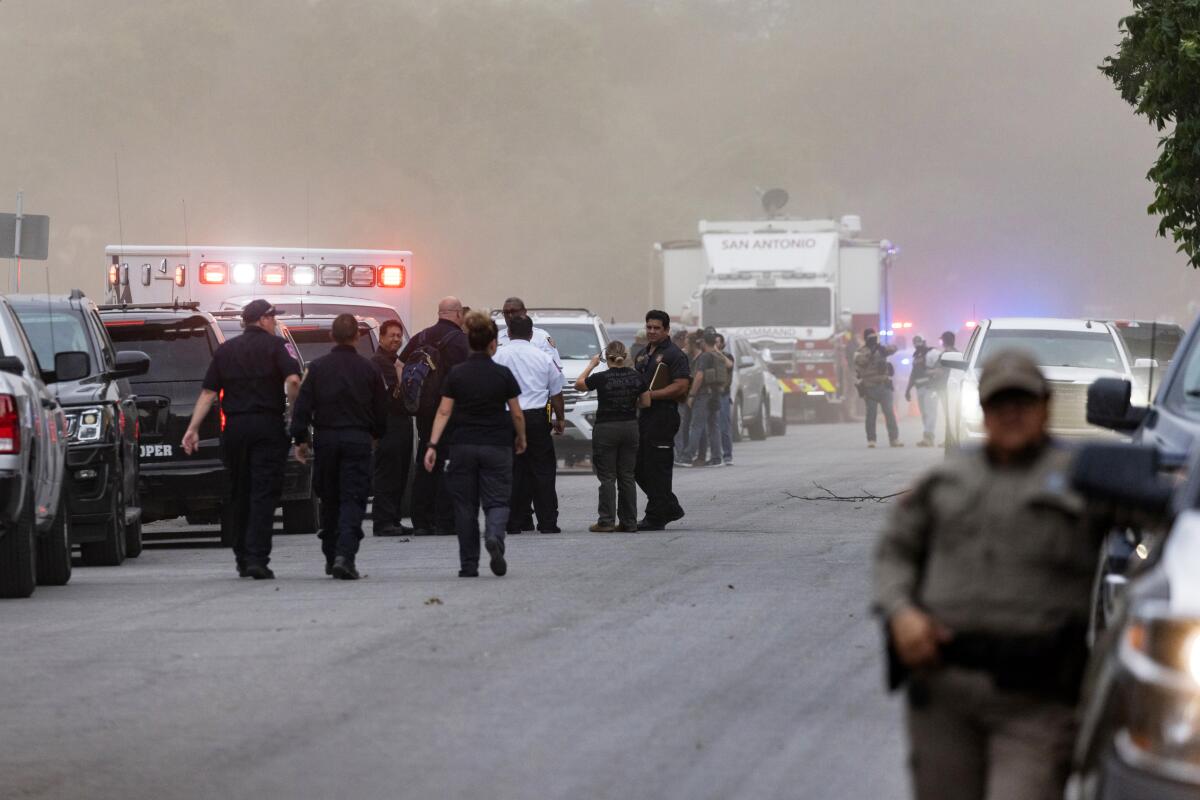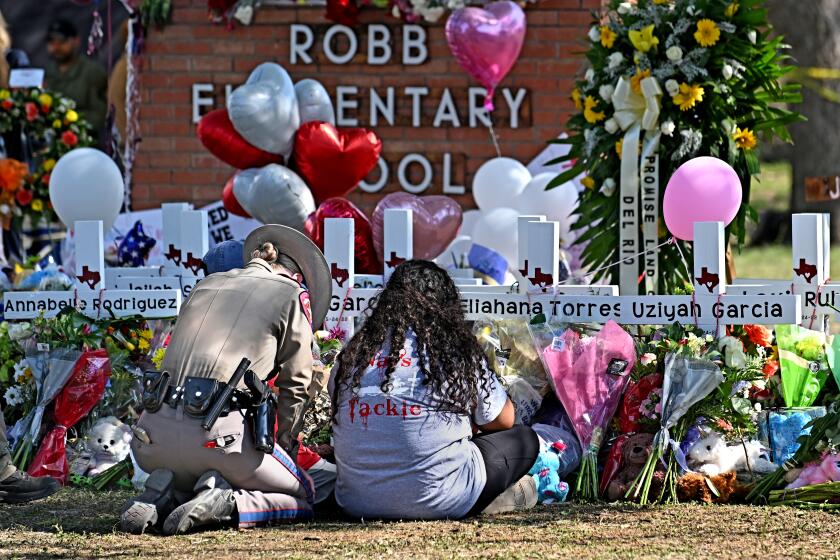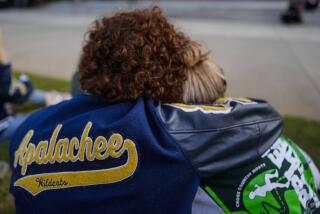Police face growing criticism over response to Texas school shooting as parents speak out

- Share via
UVALDE, Texas — With criticism swelling about the police response to the Texas elementary school massacre, a law enforcement official said Thursday that the gunman who killed 19 children and two teachers entered the school “unobstructed” through an unlocked door 12 minutes after police were alerted about a man nearby with a rifle.
Those fateful minutes — and an hour in which the police took cover outside the classroom, apparently seeking to negotiate with an active shooter — have become the focal point of questions from parents and law enforcement experts about whether more could have been done to halt the unfolding tragedy.
Victor Escalon, South Texas regional director for the Texas Department of Public Safety, said at a news briefing that the gunman, Salvador Ramos, 18, did not initially encounter any police officers when he entered Robb Elementary School in Uvalde on Tuesday and opened fire.
Ramos shot most of his victims inside the school within the first few minutes of entering, Escalon said. He was unable to explain why it took an hour for a federal special weapons team to enter the classroom and kill the gunman.
As chaos engulfed the small, predominately Latino community outside the school, some Uvalde residents — including parents who lost children — criticized the police response. Videos posted on social media, apparently recorded outside the school during the shooting, show law enforcement personnel drew weapons on parents and pinned one parent to the ground to prevent them from entering the building.
“Everyone was like, ‘What’s going on?’ ” said Derek Sotelo, 26, who was outside the school Tuesday with a friend whose son is a Robb student. The friend was frantically trying to get police to go in — or go in himself: “What the heck’s going on? Why aren’t they going in? What are they waiting for?”
His friend, he said, screamed at a cop: “Man, give me your vest. You’re not doing nothing with it! Give me that vest and I’ll go in and kill that guy!”
Law enforcement experts across the country said the police response in the working-class city of about 16,000 appeared to fall significantly short of national best practices for dealing with active shooters in school.
“Charge. Don’t wait. Run toward the threat and engage,” said Art Acevedo, the former police chief of Houston, Austin and Miami.
“We learned after Columbine and other mass shooting incidents that in a world of high-capacity firearms, the carnage occurs quickly, and not engaging immediately is not an option, especially when shots are actively ringing out,” Acevedo said.
San Antonio-area congressman Joaquin Castro on Thursday urged the FBI to investigate local law enforcement actions. “The people of Uvalde, of Texas, and of the nation deserve an accurate account of what transpired,” the Democrat wrote in a letter to the FBI.
Over the last two days, Texas officials have provided changing and sometimes contradictory narratives of what happened at Robb Elementary, from whether the school security officer and the gunman exchanged fire outside to how long law enforcement officers took cover and waited for backup as the gunman barricaded himself in a classroom.
A gunman killed 19 children and two adults at an elementary school in Uvalde, Texas, about 80 miles west of San Antonio, on May 24, 2022.
The gunfire began just after 11 a.m., when Ramos shot his grandmother in the face at her Uvalde home. According to officials, Ramos then posted a social media message declaring that “I’m going to shoot an elementary school” and drove off at high speed in his grandmother’s pickup truck.
At 11:28 a.m., Ramos crashed the truck in a concrete drainage ditch and jumped out of the passenger side, carrying a long-arm rifle. He fired at two people at a nearby funeral home as he walked toward Robb Elementary, climbed a fence and crossed the school parking lot.
At 11:40 a.m., he walked around the west side of the one-story brick school, shot multiple rounds and entered through an unlocked door. After making his way down a series of short hallways, he turned left and entered an empty classroom. From there, he found an adjoining classroom full of students and opened fire, authorities said.
Four minutes after Ramos entered the school, officers with the Uvalde Police Department and Uvalde Consolidated Independent School District Police Department went inside. Hearing gunfire, they attempted to enter the classroom, authorities said, but some were shot or grazed and took cover. Sporadic gunfire erupted as police attempted “negotiations,” Escalon said.
“During the negotiations, there wasn’t much gunfire apart from keeping officers at bay,” he said.
It was not until an hour after police entered the building that a Border Patrol tactical team arrived and killed Ramos.
Despite being just the latest in a long series of school massacres and other mass killings, the Uvalde tragedy has set off a wave of anger and frustration across the nation amid a renewed outcry for gun control legislation. President Biden and First Lady Jill Biden are to travel to Uvalde on Sunday “to grieve with the community that lost 21 lives in the horrific elementary school shooting,” the White House said.
The trip will mark the second time in less than two weeks that the Bidens have visited a community left reeling after a mass shooting. They flew to Buffalo, N.Y., to console families of the victims of a May 14 shooting at a grocery store that left 10 people dead.
The latest mass killing leaves many questions unanswered, beyond the issue of why it is so easy for an 18-year-old to purchase and then use weapons of mass carnage. Among them: How was the shooter able to enter the school so easily? Why did officers not enter the classroom sooner? Why did they try to “negotiate” with a man shooting at children?
“Once we interview all those officers — what they were thinking, what they did, why they did it, the video, the residual interviews — we’ll have a better idea,” Escalon said. “Could anybody have gotten there sooner? You’ve got to understand, small town. You have people from Eagle Pass, from Del Rio, Laredo, San Antonio responding to a small community.”
The Uvalde school district formed a police department a few months after the 2018 school mass shooting in Parkland, Fla. It has six officers and a security guard.
The gunman breached a school in a district that has threat assessment teams at each school, a threat reporting system, social media monitoring software, fences around schools and motion detectors to detect campus breaches, according to online district records.
“Teachers are instructed to keep their classroom doors closed and locked at all times,” according to its preventative security measures.
In an interview with CNN on Thursday afternoon, Lt. Christopher Olivarez, a Texas Department of Public Safety spokesman, defended the law enforcement response. “Officers were in that building within minutes,” he said.
After two officers were wounded inside the school, Olivarez added, other officers continued to maintain a presence to prevent the gunman from going to other classrooms and to allow their colleagues to evacuate children. Upon arrival, a Border Patrol tactical officer formed a tactical entry team with a sheriff’s deputy and two officers and, using a ballistic shield, breached the classroom and killed the gunman.
Some law enforcement experts, however, criticized the approach of waiting for backup.
“With an active shooter, you are not waiting for cavalry,” said Horace Frank, a retired Los Angeles Police Department assistant chief. “You used to wait for SWAT, but that leads to lives being lost. So at the LAPD, we taught officers to be prepared to make the entry themselves. Many, many departments followed that approach. There is even a video put out by the FBI teaching officers about the need for immediate entry.”
Police responses to “active shooter” situations in the 23 years since the Columbine High School shooting, which left 13 dead in Colorado, call for officers to rush in to kill or arrest a shooter and can reduce the potential death toll of a heavily armed assailant, authorities say.
For years, the standard approach was for police to surround an active shooting scene, assess the situation and attempt to negotiate in hopes of avoiding a violent showdown. Today, police are trained to kill or arrest any shooters before taking other actions, including helping victims.
Acevedo said it took police several years and multiple iterations of training based on the after-action lessons learned. “But police tactics evolved from wait for the first four officers before moving in, to today, where most agencies train that even a solo officer must advance and engage the threat,” he said.
The law enforcement response in Uvalde casts parallels to what unfolded in Parkland when a gunman killed 17 high schoolers and teachers at Marjory Stoneman Douglas High.
Surveillance video later showed the school resource officer on duty, Scot Peterson, took cover outside the school for 40 minutes while the gunman rampaged through the building. One Broward County deputy took a full minute to put on his vest as shots were heard across the school. Less than a year later, Florida Gov. Ron DeSantis fired Broward County Sheriff Scott Israel, saying he failed to keep children safe.
Fred Guttenberg, whose 14-year-old daughter, Jaime, was killed at Stoneman Douglas, said that he did not have a lot of details about the Uvalde shooting, but that it appeared to him the gunman was “in that building alone by himself for a very expansive period of time.”
“If that is, in fact, the case, this is another failure of law enforcement to protect our kids,” he said.
But Guttenberg, a gun control activist, said the solution was not as simple as urging police officers to arm up to respond more quickly and more forcefully.
“We now have gunmen that are out-arming our police, and that’s a problem,” he said, noting that the officer who tried to stop the shooter in Buffalo was killed.
“The good guys with the guns,” he said, “they’re dying too.”
Some families said lives could have been saved if law enforcement had secured the school and responded more speedily.
Carlos Ovalle, 32, a county worker who arrived at the school minutes after noon, handgun holstered on his hip, prepared to rush into the school to save his 8-year-old daughter, Makaylah. But he saw police telling other parents to stay off school grounds. When two other fathers tried to grab their children as they were being evacuated to a nearby building, Ovalle said, police arrested and handcuffed the fathers.
“I thought if I do that, I’m never going to be able to get her.”
So he waited, feeling useless — until he reunited with his daughter at the civic center three hours later.
He faulted law enforcement’s slow response.
“They failed,” he said. “Someone off duty got there faster than they did.”
Jose Cazares, who lost his niece, fourth-grader Jackie Cazares, said his brother, Javier, was frustrated that he had to watch police wait outside after he rushed to the school.
“There’s all this police presence, and he’s going, ‘Let me in, let me in!’ ” Cazares, 54, of Lubbock, said of his brother as he visited the victims’ memorial Thursday.
“They have the training to do what they’re supposed to do,” Cazares said of officers. If only, he said, “they would have done what they were supposed to do from the beginning.”
But not all Uvalde parents and family members who had children inside the school were critical of law enforcement.
Monique Hernandez, whose 8-year-old son, Joaquin, survived, said she rushed to the scene after getting a call about the shooting from a family member in law enforcement. Officers were already surrounding the building and parents were frantic, telling the officers to “just to go in.”
The officers were doing everything in their power to help the children, she said, and did not deserve criticism.
“You want to talk down on them? No. They did everything,” she said. “They got fired at, they took bullets, they did everything. They were here within minutes.... They did their damn job.”
Laura Pennington, 37, a substitute teacher with the Uvalde district whose 8-year-old son, Adam, was inside the school, said she thought law enforcement responded rapidly.
“The kids were evacuated very quickly,” she said, noting she was reunited with Adam at 1:30 p.m. “It wasn’t long before I saw him. I felt like they did a good job.”
But she said Uvalde schools need more security cameras and guards and should allow school staff to arm themselves rather than relying on locked doors.
“The classroom door is the only barricade,” she said as she stood in a town park with her son facing a memorial to the victims — 21 crosses.
“There’s more surveillance at a Circle K. He’s more important than my $5 or a pack of cigarettes. Why don’t they put more security? Where are the security cameras? Where’s the ballistic glass?”
Rector and Hennessy-Fiske reported from Uvalde, Jarvie from Atlanta and Winton from Los Angeles. Times staff writers Hayley Smith in Los Angeles and Courtney Subramanian in Washington contributed to this report.
More to Read
Sign up for Essential California
The most important California stories and recommendations in your inbox every morning.
You may occasionally receive promotional content from the Los Angeles Times.















